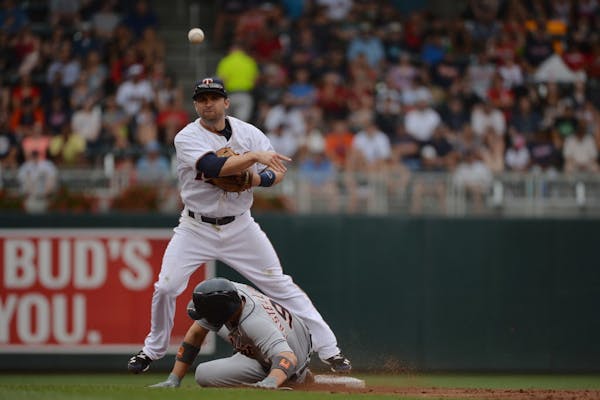There is little that makes a fan base feel more warm and fuzzy than unexpected success. When expectations are low and results turn positive, the media and the public have a tendency to look beyond sheer performance and to such things as coaching and attitude to explain a turnaround.
The fans also have a tendency to purchase tickets in larger numbers than was the case in a prior season.
The 2015 Twins are experiencing such success, and there have been tributes directed to new manager Paul Molitor and his coaches for their work with this roster, and to veteran Torii Hunter for bringing a different environment to the clubhouse and even the dugout.
The Twins are in contention and have the best home record in the American League at 31-16. A year ago, they were 22-25 after 47 home games and out of contention.
That makes it something of a puzzle that the Twins trail last year's home attendance: 1,261,695 now, compared to 1,312,774 after 47 dates in 2014.
The Twins' explanation would be that a drop in season tickets accounts for roughly 4,000 tickets sold per game, and that the fans are buying single-game tickets at a better pace.
That's accurate, but when you consider the favorable schedule, with the Cardinals and the Cubs here for five games last month, and Detroit here for four games last weekend … I'm surprised the public has not put their arms around this club with more enthusiasm.
The excuse for mediocre attendance — ninth among 15 AL teams — would be the four lousy seasons that preceded this one.
The obvious comparison in recent times would be the 2001 Twins. That was in the Metrodome, of course, where the standard for attendance was much lower.
Two reasons: The Dome's stultifying atmosphere compared to Target Field's, and the absence of a significant season-ticket base in the early 2000s.
The 2001 Twins were coming off eight consecutive losing seasons, not four. Attendance had bottomed out at 1,000,760 in 2000, 14th (and last) in the league.
Tom Kelly stuck around to manage the 2001 club, because he wanted to see potential start to be reached. The Twins went into the All-Star break at 55-32, having won 13 of 15 and holding a five-game lead in the AL Central.
They had three All-Stars in starting pitchers Joe Mays and Eric Milton and shortstop Cristian Guzman. They also had Brad Radke as a standout starter. The 1-2-3 at the top of the rotation was the primary reason for that Twins team's turnaround.
Guzman played the first game after the All-Star Game, then admitted he had been playing with a painful right shoulder and went on the disabled list for over a month. The power numbers weren't the same, but losing Guzman during that dynamic season was the equivalent of the current Twins going without Brian Dozier.
The Twins topped out at 57-33, and then hit the wall, closing 28-44. At the end, they were 85-77 and six games behind Cleveland in the Central, and guess what?
If there had been a second wild card, as is the case in 2015, it would have been the Twins.
It wasn't the balanced American League in 2001 that we're seeing today: the Mariners won 116 games, Oakland 102, the Yankees 95 and Cleveland 91 to make up the playoff field.
The 2001 Twins were rewarded by the fans with an attendance increase to 1,782,929 — 11th in the AL rather than last.
To repeat: The attendance standards are much different in 2015 at Target Field. And, yes, 23 games over .500 and first place at the break was more compelling than nine games over and in wild-card position.
What I'm saying, though, is bandwagon climbing is less enthusiastic (by percentage) than the last time Minnesota had a ballclub attempting to turn around a dreadful streak of losing.
Dozier, based on performance and aw-shucks personality, should be the most popular athlete in the Twin Cities at this moment. Hunter has brought more energy in the field than could have been imagined. Eddie Rosario, an exceptional rookie, now has been joined by the dangerous Miguel Angel Sano.
In 2001, with steroids still inflating hitting numbers, the Twins lowered the team ERA from 5.14 a year earlier to 4.51. In 2015, in baseball's new strikeout era, the Twins have lowered the team ERA from 4.57 to 3.81.
The similarities are strong at the break between these two collections of turnaround Twins. Molitor's bunch has a tough road ahead with the schedule, and maybe there will be a slide as in 2001.
For now, the 2015 Twins deserve the benefit of the doubt, and more bandwagon climbing than has been seen at Target Field so far.
Patrick Reusse can be heard 3-6 p.m. weekdays on AM-1500. preusse@startribune.com
Reusse: Shaver was 'Voice of the North Stars' and an all-time great guy

Reusse: There's no doubt Finch is the right coach for the Wolves

Reusse: How bad are the White Sox? They made Twins look good.

Reusse's Tortured Columnist Department update: Yes, Vikings won the offseason


